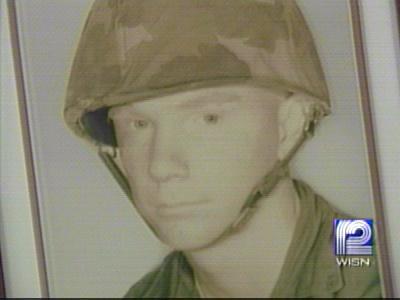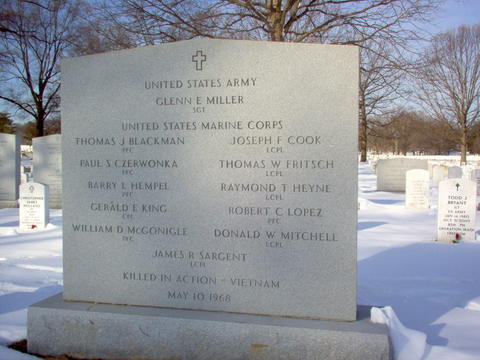NEWS RELEASE from the United States Department of Defense
No. 820-05
IMMEDIATE RELEASE
August 10, 2005
The Department of Defense POW/Missing Personnel Office (DPMO) announced today the identification of the remains of 12 U.S. servicemen missing in action from the Vietnam War. Five of those identified are being returned to their families for burial, and the remaining seven will be buried as a group in Arlington National Cemetery, near Washington, D.C.
The men who were individually identified are: Corporal Gerald E. King, of Knoxville, Tennessee; Lance Corporals Joseph F. Cook, of Foxboro, Massachusetts; Raymond T. Heyne, of Mason, Wisconsin; Donald W. Mitchell, of Princeton, Kentucky.; and Thomas W. Fritsch, of Cromwell, Connecticut, all of the U.S. Marine Corps.
Additional group remains are those of: Privates First Class Thomas J. Blackman, of Racine, Wisconsin; Paul S. Czerwonka, of Stoughton, Massachusetts; Barry L. Hempel, of Garden Grove, California; Robert C. Lopez, of Albuquerque, New Mexico; William D. McGonigle, of Wichita, Kansas; and Lance Corporal James R. Sargent, of Anawalt, West Virginia, all of the U.S. Marine Corps. Additionally, the remains of U.S. Army Sergeant Glenn E. Miller, of Oakland, California, will be included in the group burial.
The Marines were part of an artillery platoon airlifted to provide support to the 11th Mobile Strike Force, which was under threat of attack from North Vietnamese forces near Kham Duc in South Vietnam. On May 9, 1968, the Strike Force had been directed to reconnoiter an area known as Little Ngok Tavak Hill near the Laos-Vietnam border, in the Kham Duc Province. Their base came under attack by North Vietnamese Army troops, and after a 10-hour battle, all of the survivors were able to withdraw from the area.
Six investigations beginning in 1993 and a series of interviews of villagers and former Vietnamese soldiers led U.S. recovery teams in 1994, 1997 and 1998 to specific defensive positions within the large battle site. Additionally, maps provided by American survivors helped to locate some key areas on the battlefield. Three excavations by the Joint POW/MIA Accounting Command (JPAC) in 1998 and 1999 yielded human remains, personal effects and other material evidence.
JPAC scientists and Armed Forces DNA Identification Laboratory specialists used mitochondrial DNA as one of the forensic tools to help identify the remains.
Of the 88,000 Americans missing in action from all conflicts, 1,815 are from the Vietnam War, with 1,381 of those within the country of Vietnam. Another 768 Americans have been accounted for in Southeast Asia since the end of the war. Of those, 540 are from within Vietnam.
For additional information on the Defense Department’s mission to account for missing Americans, visit the DPMO Web site at http://www.dtic.mil/dpmo or call (703) 699-1169.
American’s Recovered From Vietnam
August 2005
Burial 7 October 2005
Thomas J. Blackman
Private First Class, United States Marine CorpsPaul S. Czerwonka
Private First Class, United States Marine Corps
Paul S. Czerwonka
Private First Class, United States Marine Corps
Barry L. Hempel
Private First Class, United States Marine Corps
Robert C. Lopez
Private First Class, United States Marine Corps
William D. McGonigle
Private First Class, United States Marine Corps
James R. Sargent
Lance Corporal, United States Marine Corps
Glenn E. Miller
Sergeant, United States Army
Czerwonka laid to rest
By Mike Pazyra/ Special To The Journal
Friday, October 14, 2005His life. That’s what his country asked of him. That’s what he gave for his country.
On October 7, 2005, 37 years after his death at age 18 in another world, from a now distant time, son of Stoughton Paul Steven Czerwonka was laid to his final resting place at our nation’s most sacred and hallowed ground. Arlington National Cemetery was created for men and women like Paul Czerwonka, its majesty, magnificence and solemn beauty a fitting end to lives lived in duty and sacrifice to their country.
At 9 a.m. that morning it was raining, a light rain almost like a mist saturating the muggy atmosphere. There was hardly a breath of wind. The air was sharp and clear without a hint of fog, despite the moisture and overcast cloudy sky above. It was the right day to say goodbye.
The gravesite is in a recently expanded area of the cemetery, only a couple of hundred yards behind the Administration Building. Encroaching upon the grassy field new headstones dominate the area inscribed with dates of birth in the 1980’s. These are the headstones of men and women lost in another distant world, from a more recent time. The contrast between the beautiful and the sad is stark and overwhelming. It is difficult to control one’s emotions.
In control of their emotions and doing their jobs with professional and sincere dignity and respect, were a Ceremonial Platoon, Firing Detail and Casket Detail from the United States Marine Corps. Other branches of the United States military were similarly represented at other burials that morning. In the family rooms of the Administration Building, where family and friends gather prior to the start of a burial, large screens showed a solitary United States Army soldier guarding the Tomb of the Unknowns. As you read this now, a soldier is there performing his duty. A soldier is always there.
The family rooms were crowded that morning with not only the family and friends of Paul Czerwonka, but with those of the other six men being interred with him, all lost in the same battle. There were parents, siblings and friends, remembering them as they were and always will be.There were nieces and nephews, and other young people who know them only through old photographs and stories told through tears and pride.
DNA brings missing U.S. troops home
11 August 2005 The remains of 12 servicemen, listed as missing in action during the Vietnam War, have been identified and are returning home, 37 years after they died in a fierce battle near the Laos-Vietnam border, the U.S. Defense Department announced yesterday.
The 11 Marines and one Army soldier are the largest group of MIAs identified since the war.
“Now we don’t have to wonder any more,” said Steven Fritsch of Cromwell, Connecticut, who will bury his older brother on Sunday.
He said the news has been “bitter-sweet” for his parents.
“Obviously now they have to bury their son and whoever wants to do that?” he said. “But at least they know he’s not just missing, he actually died in battle.”
Marine Lance Corporal Thomas W. Fritsch and four others will be buried by their families. The other seven will be buried as a group in Arlington National Cemetery in October, Larry Greer, a spokesman for the Pentagon’s missing personnel office, said yesterday.
The Marines were killed during a 10-hour battle on May 9, 1968, on a football field-sized area in South Vietnam.
Mr Greer said villagers, former Vietnamese soldiers and American survivors helped investigators narrow their search to three excavations in 1998 and 1999, where they recovered the remains and other personal materials.
Since then, they have been working to identify the remains through DNA and other forensic tools, he said.
“We really feel very fortunate that we do have some remains coming home to us, and we are welcoming him home,” said Brenda Scott, whose brother, Lance Corporal Donald W. Mitchell, of Princeton, Kentucky, was among the recovered MIAs.
Their father, Herman Mitchell, died in 1998. Their mother, Marjorie Mitchell, is now aged 80 and “feels finally at peace,” Ms Scott said.
Lance Corporal Mitchell’s funeral is scheduled for August 27, more than three dozen years after his family prepared for it.
“We’ve had this family plot since 1968 with a monument ready for him to come home,” Ms Scott said.
Carol Fordahl remembered her former boyfriend, Army Sergeant Glenn E. Miller, as a young man with a crew cut who serenaded her. “I still miss him to this day,” she said. “I just wish he had been able to come back.”
Burial upsets soldier’s familyThe Pentagon’s announcement this week that it had identified the remains of 12 U.S. soldiers gone missing in Vietnam 37 years ago is being met with skepticism and anger by one of the families involved.While the family of Army Sergeant Glenn E. Miller is convinced the Green Beret died in Vietnam, they are upset by the Pentagon announcement, which said his remains will be buried in Arlington National Cemetery in October 2005.
The family says there is nothing of Miller’s to bury that the military has told them privately that none of his remains or effects were found on the battlefield.
“We are really disheartened, said his sister, Marion Miller Alschuler of Orinda. “Glen’s body was not found.”
Alschuler said she and other family members were told in May that no physical evidence of her brother was found at a battlefield site where he was killed along with 11 U.S. Marines in 1968. She said the Pentagon plans to lay an empty Green Beret uniform to rest with the remains of six of the Marines. The five others will be buried individually.
Larry Greer, a spokesman for the Pentagon’s missing personnel office, wouldn’t say what physical evidence of Miller’s death if any was found at the battlefield site, calling that a private matter. He said eyewitness accounts indicate that Miller “clearly died at the site.”
“I don’t know the details the Army briefed to the family about Glenn Miller, including the details of his recovery, nor the burial details, Greer said. “There was a huge amount of other personal effects recovered at this battle site which gave the forensic anthropologists sufficient evidence to conclude that all 12 men died in this area.”
The Defense Department said Tuesday that the 12 men — 11 Marines and one Army soldier — represent the largest group of MIAs identified after going missing in the Vietnam War, said Larry Greer, a spokesman for the Pentagon’s missing personnel office.
“Now we don’t have to wonder anymore,” said Steven Fritsch of Cromwell, Connecticut, who will bury his older brother Sunday at St. John’s Catholic Church in Cromwell.
He said the news has been “bittersweet” for his parents.
“Obviously now they have to bury their son, and who ever wants to do that?” he said. “But at least they know he’s not just missing, he actually died in battle.”
Marine Lance Corporal Thomas W. Fritsch and four others will be buried by their families. The other seven will be buried as a group in Arlington National Cemetery in October, said Larry Greer, a spokesman for the Pentagon’s missing personnel office.
The Marines and Army sergeant were killed during a 10-hour battle on May 9, 1968, on a football field-sized area in South Vietnam, said Greer. He said they were part of an artillery platoon airlifted in to support a unit that was at risk of an attack from nearby North Vietnamese forces. All part of the 11th Mobile Strike Force, they were trying to scout an area when they were attacked by North Vietnamese Army troops, said Greer.
The Vietnam Veterans of America and other advocates urged the excavation at the site, said Tim Brown of Dallas, a member of the platoon.
Greer said villagers, former Vietnamese soldiers and American survivors helped investigators narrow their search to three excavations in 1998 and 1999, when they recovered the remains and other personal materials.
Since then, they have been working to identify the remains through DNA and other forensic tools, he said.
“We really feel very fortunate that we do have some remains coming home to us, and we are welcoming him home,” said Brenda Scott, whose brother, Lance Cpl. Donald W. Mitchell, of Princeton, Ky. was among the recovered MIAs. Mitchell’s father, Herman Mitchell, died in 1998 without fully knowing his son’s fate. His mother, Marjorie Mitchell, is now 80 and “feels finally at peace,” Scott said.
Mitchell’s funeral is scheduled for August 27, more than three dozen years after his family prepared for it.
“We’ve had this family plot since 1968 with a monument ready for him to come home,” said Scott.
Carol Fordahl remembered her former boyfriend, Army Sergeant Glenn E. Miller, as a young man with a crew cut who serenaded her with his guitar from her roof top and mailed her fresh cherries for her birthday. She still has the pearl ring and charm bracelet that the Green Beret from Oakland, California, gave her.
“I still miss him to this day,” she said. “I just wish he had been able to come back. He had a lot to offer. He was an exceptional person and a really, really good friend. I think of him often.”
Marine Private First Class Robert Lopez, of Albuquerque, New Mexico, also was among the missing Marines. His sister, Margaret Coplen, said Lopez died a year after he graduated from high school. The last time she heard from him was in a letter that arrived a few days after the military informed the family about what happened to him. In it, he described being able to squeeze in a bath in a river.
“He said he at least felt he was halfway clean,” she said. “It was in a river, so he said when he came out, he was covered with leeches. I was just crying when I had read that.”
Along with King, Fritsch, Lopez, Mitchell and Miller, the men who were identified were Lance Cpls. Joseph F. Cook, of Foxboro, Mass.; Raymond T. Heyne, of Mason, Wis.; Pfcs. Thomas J. Blackman, of Racine, Wis.; Paul S. Czerwonka, of Stoughton, Mass.; Barry L. Hempel, of Garden Grove, Calif.; William D. McGonigle, of Wichita, Kan.; and Lance Cpl. James R. Sargent, of Anawalt, W. Va., all U.S. Marine Corps.
The Defense Department says 1,815 Americans are still missing in action from the Vietnam war.
Racine Vietnam Marine To Finally Get Proper Burial
Parents Receive Dog Tags
11 August 2005
RACINE, Wisconsin – After 37 years, a Racine Marine killed in Vietnam will finally be laid to rest.Private First Class Thomas Blackman was killed along with 11 other marines during a 10-hour battle in May 1968.
Seven of the marines have been positively identified by DNA or their personal effects.
Last week, Blackman’s dog tags arrived at his parents’ home.
“We thought we were going to get them a year or so ago. Then we thought we were going to get them a few months ago. Then I got on the telephone, and I started asking and asking and we got them,” Thomas Blackman’s father, Don Blackman, said.
In October, Blackman’s parents plan to attend a group funeral for their son and the other marines at Arlington National Cemetery.
Family mourns again for fallen local soldierOn May 10, 1968, 18-year-old Private First Class Paul A. Czerwonka circled back toward an advancing enemy.Czerwonka was on a team of 11 Marines picking their way through the jungles of South Vietnam, searching for two lost comrades. Before the end of the day, he and his fellow soldiers would be lost themselves. Cut down by the North Vietnamese, their bodies would lay where they had fallen, unseen on a napalm-scarred hillside.
And their names would be added to the rolls of those declared missing in action.
In his hometown of Stoughton, Czerwonka’s parents, Paul and Ida, and his four siblings, Dean, Joann, John and Katherine, would spend the next 37 years believing the young man they loved was probably dead, but always wondering if there was some slight hope.
The wondering came to an end Tuesday when the Department of Defense formally identified the remains of 11 Marines, Czerwonka among them, and one Army soldier. Their remains, gear and personal effects were found on a hill in southern Vietnam at the site of a bloody battle fought near the Laos border.
Czerwonka’s younger brother, Dean, said Wednesday news of the identification has been hard on the family.
“It’s tough,” he said, particularly for his 79-year-old mother. “My mother, as old as she is, is having a tough time dealing with it … I’ve been an emotional wreck for the last 24 hours.”
But there is also hope for a new beginning.
“When we go down to Arlington (National Cemetery) for the burial, that will be a time for us to be together as a family,” Dean said.
Dean, 50, now lives in Canton and owns a used car dealership in Brockton. He was 13 when his brother Paul left Stoughton High School to join the Marines.
Dean said Paul volunteered for duty in Vietnam, duty he could have skipped because their older brother, John, was already serving there as a crew member aboard a Navy Swift boat.
But, after basic training at Camp Lejeune, South Carolina, and assignments in California and Hawaii, Czerwonka was deployed to Vietnam.
On the morning of his death, Czerwonka and the rest of the Marines from Battery D, 2nd Battalion, had been flown in to support soldiers at the Kham Duc Special Forces Camp on the Laos border, according to military records. They fought off Viet Cong and elements of the North Vietnamese Army in a desperate bid to hold the base.
At 3:15 a.m., an NVA battalion loosed a shower of mortar rounds, bullets and grenades. With the first volley, Viet Cong, posing as friendly South Vietnamese soldiers, ran back through the base, tossing grenades and firing their carbines before they could be gunned down.
The battle continued through sunrise.
Larry Greer, a spokesman for the Pentagon’s missing personnel office, said the Marines were outnumbered. The 100 Marines faced three times their number in enemy soldiers. Two helicopters were shot down as they tried to ferry in reinforcements and evacuate wounded. Despite air support, casualties were heavy.
By noon, with ammunition and supplies running low and the odds of reinforcement slim, the decision was made to abandon the base and retreat into the jungle.
But about one kilometer into their march, someone noticed two men — medic Thomas Perry and Sergeant Glenn Miller — were missing.
Czerwonka was among a team of 11 Marines who circled back to search for Miller and Perry.
All 11 were killed when the team came under attack. Czerwonka was cut down by small arms fire.
He died just 10 days before his 19th birthday. His brother, John, who had taken leave from his Swift boat to visit Paul, was the first to hear he was missing.
His father, also named Paul, died in 1998 without learning the facts of his son’s death.
More than three decades after Czerwonka was declared missing, interviews with American survivors, villagers and former Vietnamese soldiers led teams from the Joint POW/MIA Accounting Command to specific sites on the battlefield where soldiers were thought to have been lost. Excavations in 1998 and 1999 yielded human remains, personal effects and other material evidence, according to Greer.
And early in the summer, five soldiers had been positively identified through DNA testing. The remains of Marine Cpl. Gerald E. King of Knoxville, Tenn.; Lance Cpls. Joseph F. Cook of Foxboro, Mass.; Raymond T. Heyne of Mason, Wis.; Donald W. Mitchell of Princeton, Ky.; and Thomas W. Fritsch of Cromwell, Conn., will be returned to their families for burial.
The remaining seven soldiers, Marines Czerwonka; Pfc. Thomas J. Blackman of Racine, Wis.; Barry L. Hempel of Garden Grove, Calif.; Robert C. Lopez of Albuquerque, N.M.; William D. McGonigle of Wichita, Kan.; Lance Cpl. James R. Sargent of Anawalt, W.Va., and Army Sgt Glenn E. Miller of Oakland, Calif., were identified to the satisfaction of their families and the military.
The surviving Czerwonka family includes Dean; his mother, Ida, who divides her time between homes in Brockton and Florida; Joann, 51, of Brockton; Katherine, 45, of Bridgewater, and John, 58, of Brockton.
They were first told earlier this summer that Paul’s remains might have been discovered.
“We’ve known for about two months,” Dean said.
Because his remains could not be individually identified, they will be buried with those of his six fellow soldiers in October at Arlington National Cemetery in Virginia.
“They didn’t give us an exact date” for the burial, Dean Czerwonka said.
He said not having an individual identification has been difficult but “in the way they described it, it’s a 99 and 9/10ths certainty.”
Something of his brother’s may have been found among the remains.
“He always used to carry a Zippo lighter with him. There was one Zippo lighter in there, but how am I to know if it was his?” Dean said.
Plans for a local service have yet to be finalized.
Dean said the family would like to add a memorial to the square dedicated to his brother at the corner of Turnpike and Page streets in Stoughton.
Stoughton veterans agent Mike Pazyra said he has yet to discuss the idea with the family but is “certain there will be some type of (local) memorial event.”
Maureen Dunn of Randolph knows something about the pain of not knowing.
Dunn’s husband, Navy Lt. Cmdr. Joseph Dunn, was 25 when his military plane went down over China on Feb. 14, 1968 while flying back to the aircraft carrier USS Coral Sea in the Gulf of Tonkin. Dunn was not listed as missing in action until 1981, when the Navy declared him “presumed dead.”
“These young men are now dead,” Maureen Dunn said of the 12 missing soldiers now identified. “They’re not in limbo anymore.”
Of the 88,000 U.S. servicemen listed as missing in action, about 1,800 were lost during Vietnam, according to Greer. Just over 100 went missing during the Cold War, more than 8,000 in Korea and 78,000 during World War II.
Dunn, active among POW/MIA support groups, said the families of Vietnam MIAs have pushed the government to find lost soldiers harder than any other generation.
“The families fight very hard,” she said. “World War II families, God love them, accepted it for whatever reason.”
Ex-girlfriend recalls Viet War MIA soldier
His remains found at ’68 battlefield with those of 11 others
Thursday, August 11, 2005Carol Fordahl kept the charm bracelet that her high school sweetheart Glenn Miller gave her for her 15th birthday, before the East Oakland neighbors broke up and he went off to fight in Vietnam four decades ago.This week, the Livermore grandmother learned that the remains of Miller – – a Green Beret listed as MIA for 37 years — have been identified using DNA and other evidence, and returned to the United States.
“It’s worse finding it out like this, rather than thinking he might still be alive somewhere over there,” said Fordahl, recalling the tall, adventurous young man who taught her to sail and took her for rides in an old Ford he had restored himself. “It makes it really final. It’s really sad.”
Miller and 11 Marines were killed in a battle in 1968 on the Laos-Vietnam border. Their remains are the largest group of U.S. servicemen killed in a ground battle ever to be identified after going missing in the Vietnam War, said Larry Greer, spokesman for the Pentagon’s missing personnel office.
Military representatives have met personally with the families of each of the servicemen, five of whom will be buried by the families, Greer said. The remaining seven — including Miller — will be buried as a group in a single tomb at Arlington National Cemetery on Oct. 11.
Miller’s relatives could not be reached Wednesday, and Greer said they did not want to comment.
Fordahl said that she and Miller lived just four doors apart on Greenly Drive in East Oakland. She has kept the charm bracelet he gave her, along with a pearl ring and a pin that said, “Carol and Glenn.”
Shortly before he left for Vietnam, Miller visited her and she had a bad feeling, Fordahl said.
“I just felt in my heart he wouldn’t be back,” she remembered.
Miller was with the Army’s 11th Mobile Strike Force, which called in a Marine artillery platoon for help under attack by North Vietnamese army forces. Miller was killed during a fierce, 10-hour battle on May 9, 1968, along with 11 of the 44 Marines who had come to help, Greer said. While some survivors were airlifted that day, others had to cross enemy lines and hike 6 miles to safety, Greer said.
Beginning in 1993, villagers, former Vietnamese soldiers and American survivors helped investigators identify key areas of the battlefield, which was roughly the size of a football field. Those sites were excavated in 1998 and 1999. Forensic scientists used survivor accounts, dental records and DNA testing to identify the 12 sets of remains, Greer said.
Margaret Lopez-Coplen said she was asked to give a DNA sample in 1999, which helped to positively identify the remains of her brother, Pfc. Robert C. Lopez of Albuquerque. Lopez was born at Oakland Naval Hospital and lived in the Bay Area as a toddler.
Lopez died at age 19, one year after graduating from high school and just 2 1/2 months after arriving in Vietnam. His sister described the news that his body has been identified as “bittersweet.”
“It closes up all the wondering you had for so many years,” said Lopez- Coplen. “It’s a relief my brother is going to be laid to rest in a place of honor.”
She said that learning his remains had been positively identified brought back a flood of memories, including when she received the last letter her brother wrote — after the family was notified of his death.
“He had told me there was a river nearby, and he’d finally had the opportunity to take a bath. But when he came out, he was covered in leeches,” Lopez-Coplen recalled. “I cried and cried after I read that.”
In addition to Miller and Lopez, the men who were identified were Marine Cpl. Gerald E. King of Knoxville, Tenn.; Marine Lance Cpls. Joseph F. Cook of Foxboro, Mass., Thomas W. Fritsch of Cromwell, Conn., Raymond T. Heyne of Mason, Wis., Donald W. Mitchell of Princeton, Ky., and James R. Sargent of Anawalt, W.Va.; and Marine Pfcs. Thomas J. Blackman of Racine, Wis., Paul S. Czerwonka of Stoughton, Mass., Barry L. Hempel of Garden Grove (Orange County) and William D. McGonigle of Wichita, Kan.
According to the Department of Defense, 1,815 Americans are missing in action from the Vietnam War.
US MIAs identified in Vietnam
11 August 2005The remains of 12 US servicemen who were killed together in battle in the Vietnam War 37 years ago have been identified and are being returned to their families for burial, the Pentagon said.The 11 Marines and one Army soldier were lost on May 9 and 10, 1968, in a battle near Kham Duc in South Vietnam when their units were overrun by North Vietnamese forces, the Pentagon’s POW/Missing Office said.
The Pentagon has scheduled a ceremonial group burial on October 11 at Arlington National Cemetery, said Larry Greer, a spokesman for the office.
The remains of the 12 servicemen were recovered over the course of several investigations and excavations that began in 1993, he said.
“Our teams over there interviewed North Vietnamese or communist soldiers that actually participated in the attack and they were helpful in pointing out what they knew about the battle site,” Greer said.
He said investigators also were aided by American veterans of the battle who provided hand-drawn maps of where they thought their comrades had fallen.
US forensic experts at a Pentagon laboratory in Hawaii completed identifications of the servicemen in March, Greer said. US military officials scattered across the country completed briefings with the families near the end of July.
AdvertisementAdvertisementOf the 12 servicemen, only five have been individually identified. Hundreds of other remains fragments that were too small to do DNA testing on will be buried in a single casket representing all 12 of the men, Greer said.
More than 58,000 Americans and 2 million Vietnamese were killed in the Vietnam War, which ended 30 years ago.
When Billy McGonigle didn’t come home after the Vietnam War, it took a toll on his family.Now, nearly four decades after he disappeared, his parents are beginning to realize how he lived and died.On May 23, Harry and Grace McGonigle received two black books documenting the discovery of their son’s remains on a mountaintop near Vietnam’s border with Laos.
He had been declared missing in action after the Battle of Ngok Tavak 37 years ago.
His remains will be laid to rest in October in Arlington National Cemetery, along with those of other MIAs from the same battle. It will be one of the largest services for MIAs since the end of the Vietnam War.
And it will close a chapter for Vietnam-era Wichitans.
Billy McGonigle is the last Wichita MIA to be identified from the Vietnam War, according to state VFW officials. Kansas still has 31 people classified as missing in action, and the search for them will continue, said James “Big Jim” Denison, POW/MIA chairman for the Department of Kansas Veterans of Foreign Wars.
Wichitan Richard Smith’s remains were returned in 1994 and buried in Resthaven; Jerry Hendrix was buried in Arlington in July 2004.
Denison hopes more families can find resolution as the United States and Vietnamese governments continue to negotiate.
From the get-go, Billy McGonigle showed he had a mind of his own.
One time, Harry McGonigle remembers, a dog bit Billy. Billy bit the dog right back on the ear.
“The dog never bit him again,” Harry McGonigle said.
His mother says she doesn’t know why Billy joined the Marines. He wanted to be a history teacher, and she tried to get him to go to college.
But she had three uncles who served in World War II, and his stepfather, Harry, served in Korea.
“I think he did it to show he was strong,” she said.
A few months before he graduated from Wichita South High School in 1966, Billy joined the Marine Corps. He finished high school and then immediately began basic training at Camp Pendleton in California.
Grace McGonigle worried about Billy. In January 1968, the family received a standard letter saying that he had arrived safely in Vietnam and was a member of Battery D, 2nd Battalion, 13th Marines, 1st Marine Division, Fleet Marine Force.
She wrote him daily during the evening news.
“I kept hoping I’d see him on TV,” she said.
She wrote about what his brother and sister were up to, how his grandmother was doing and if any word had come from his high school friends.
Five months into his stint, Billy and about 40 other Marines set out from the American base at Da Nang. They were headed for the forward operating base at Ngok Tavak, near the Special Forces camp at Kham Duc, to counter a North Vietnamese push against Kham Duc.
Billy volunteered to go on the special mission, said Dave Fuentes, now of Oak Forest, Ill.
“He took somebody else’s place,” Fuentes said. “A lot of the guys knew we probably wouldn’t be coming back. One guy started crying. Billy volunteered to go and took his place.
“That’s how he got up there.”
The men were assigned to move five howitzers up a mountain to Ngok Tavak, an old French fort. They reached the top, then were attacked by Communist Vietnamese early on May 10, 1968.
“Each of the howitzers weighed a couple of tons and it was a 30-degree incline that we had to go up,” Fuentes said. “They picked a good night to overrun us. We were totally exhausted… It was fierce fighting.”
In the midst of the battle, Fuentes recalls, McGonigle had a radio and was yelling for air support.
“He was yelling: ‘We need backup, more backup.’ ”
Billy “showed no fear. He wanted to know where he should be,” said Henry Schunck, then a corporal who was awarded the Navy Cross after the battle.
“It wasn’t a battle where people were in charge… People were shooting at you and coming at you… Awful things were going on.”
Snipers hit three or four Marines in the head, he said.
One was Billy.
Fuentes and Schunck remember where and when Billy fell. Fuentes removed Billy’s dog tags, put one in Billy’s mouth and took the other to his commanding officer, as is military policy.
The survivors carried the wounded off the mountainside and retreated along a trail to a spot where they could be flown out.
Before they could gather the dead, fighting became so intense they had to leave, Schunck said.
Scott (Doc) Thomas, a Navy corpsman who lives in Massachusetts, said he was one of the last men taken away from the battle.
“After it was all said and done, that battle site was bombed incessantly for days after… I couldn’t imagine they could ever recover any remains.”
Grace was fixing supper when she heard the knock on the door May 14, 1968.
She saw a man in a military uniform and a priest, and she screamed out: “Is he dead or hurt?”
When they asked to also see Harry, she knew it was bad.
They told the McGonigles that Billy was most likely dead, but that his status was MIA because his body had not been recovered.
For years, she refused to believe her firstborn was dead.
She says his MIA status affected the family.
“I get upset and discouraged until I’m about ready to give up,” she said. “If it weren’t for the Vietnam veterans who come around, I don’t know what I’d do. They keep me going.”
Meanwhile, the veterans of Ngok Tavak were bothered by the memory of those left behind.
It was the largest group of soldiers classified as missing in action from the Vietnam War.
“If you ask any soldier or Marine, you will know that we have a strong bond amongst ourselves – particularly those of us who have served in combat – to not leave dead on the battleground,” said Tim Brown, a Marine veteran from Chaska, Minn., who was at Ngok Tavak. “It was important to us who survived to fulfill our obligation to them as fellow Marines and to their families to do the best we could to get them home.”
For the last decade, Brown has led efforts to find those remains and to remind people what happened in the battle.
In 1999, he wrote the McGonigles to tell them how their son had died.
“Our platoon was attacked on 10 May 1968 at 3 a.m. by a huge enemy force. This resulted in a massive battle with thirteen of our men, including Billy being killed very early in the battle.”
Billy’s mother still has the letter.
“He died quickly and was among very close friends,” Brown wrote. “He did not die alone, and he most definitely was not captured.”
Because of the intensity of the battle, huge losses on both sides, the conditions of wounded soldiers and the loss of rescue helicopters, the survivors had no choice but to leave some of the dead on the field, he wrote.
No one from that battle questions that the bodies were left behind, but they wish resolution could have come sooner for the families.
Brown gently tried to tell the McGonigles in the letter that their son’s remains might be difficult to locate.
“It is possible that their remains were destroyed, or covered by dirt and debris from explosions.”
Finally, last year, Billy’s remains were found under nearly 5 feet of jungle soil.
Using maps his surviving comrades drew, an archaeological dig found bone fragments and teeth, along with the soles of shoes, a toothbrush, comb, pieces of eyeglasses, uniform and a 1968 card calendar.
DNA testing on one of the teeth showed a familial relationship to Grace McGonigle.
The McGonigles were officially informed of Billy’s death – and the recovery of his remains – on July 31, 2004.
Grace doesn’t want to believe Billy is gone even now.
“It’s just such a mess to try and live and think your son is dead,” she said. “It’s been hard not knowing for sure.”
She still wears a T-shirt bearing Billy’s Marine Corps photo. She also wears his MIA bracelet and a bracelet bearing the names of all of Kansas’ MIAs.
She and her husband plan to go to Arlington in October.
Marine’s Remains from Vietnam Identified
10 August 2005Lance Corporal James Ray Sargent of McDowell County will be buried at Arlington National Cemetery.
The remains of a McDowell County Marine missing for 37 years have been identified.The Defense Department said Wednesday the remains of Lance Corporal James Ray Sargent of Anawalt will be buried at Arlington National Cemetery in Virginia. He was 18 when he died.
According to the news release, Sargent was one of a dozen Marines whose bodies were recovered and identified.
“The Marines were part of an artillery platoon airlifted to provide support to the 11th Mobile Strike Force, which was under threat of attack from North Vietnamese forces near Kham Duc in South Vietnam,” the release said.
“On May 9, 1968, the Strike Force had been directed to reconnoiter an area known as Little Ngok Tavak Hill near the Laos-Vietnam border, in the Kham Duc Province. Their base came under attack by North Vietnamese Army troops, and after a 10-hour battle, all of the survivors were able to withdraw from the area.”
Their remains were excavated in 1998 and 1999, the Defense Department said, and eventually were identified using mitochondrial DNA, among other methods.
Sargent will be buried in a group grave at Arlington with six of the Marines, the Pentagon said. The bodies of five others are being returned to their families for burial.
At Long Last, Honors for 12 Fallen Men
Remains of Veterans Identified 37 Years After Deadly Battle in Vietnam
By Annie Gowen
Courtesy of the Washington Post
Saturday, October 8, 2005
They had waited 37 years for this moment, but family members of 12 U.S. servicemen honored yesterday at Arlington National Cemetery approached the grave site cautiously, under a shield of umbrellas. Behind them, 12 soldiers stood in the rain, each holding a flag folded just so, the blue stars just visible.
For years, relatives never knew exactly what happened that day in 1968 at Ngok Tavak, a remote hill in Vietnam, after the North Vietnamese closed in. Some got out, led by a wild Australian Army captain on a trail blazed by napalm.
Others weren’t so lucky.
For years, their families heard conflicting stories about what happened to them. They were missing. Out on a search party. Or dead.
Official documents listed Marine Lance Corporal Raymond T. Heyne of Mason, Wisconsin, with a string of inconclusive letters after his name — KIA, MIA, POW — his sister, Janice Kostello, said yesterday.
But after a 12-year investigation that included interviews with Vietnamese and U.S. soldiers and three excavations of the jungle site near the border with Laos, the Department of Defense recently was able to identify the remains of five servicemen who died during the 10-hour battle, as well as the remains of seven others who were interred in a single coffin yesterday. Heyne was buried privately in a separate grave yesterday, and four others were to be buried in their home states.
When the Defense Department finally called with the news that it had identified Heyne’s remains this spring, Kostello said she was relieved.
“Because you always wondered,” she explained. “It was closure. It was joy and it was relief and it’s sad. You’re elated because you can finally bury him.”
She is 71 now, her hair curly and white. Her adored little brother was 20 when he disappeared.
Among the men who died with Heyne that day was Marine Corporal Gerald E. King of Knoxville, Tennessee, who was injured early on but continued to fight; Lance Corporal Joseph F. Cook of Foxboro, Massachusetts, a comedian-tough guy who died along with his best friend, Private First Class Paul S. Czerwonka of Stoughton, Massachusetts; and Private First Class. Thomas J. Blackman of Racine, Wisconsin, a lanky redhead who had talked about how he wanted to ride his bicycle from coast to coast after he got home.
Also honored yesterday were Lance Corporal James R. Sargent of Anawalt, West Virginia, Lance Corporal Donald W. Mitchell of Princeton, Kentucky, Lance Corporal Thomas W. Fritsch of Cromwell, Conn., Private Barry L. Hempel of Garden Grove, California, Private Robert C. Lopez of Albuquerque, Private William D. McGonigle of Wichita, and Army Sergeant Glenn E. Miller of Oakland, California.
After the ceremony, more than 150 attendees and veterans who fought at Ngok Tavak and at a base nearby gathered at a hotel off Interstate 395 in Alexandria and swapped stories about their lost colleagues.
“Just say they took part in a major military action that was a total fiasco . . . 200 men, in the face of a [North Vietnamese] division of 8,000, who were told to stand and fight. Their chances were pretty slim,” said John White, a retired Australian military officer who commanded the troops — a mix of Marines, Australian soldiers and Chinese mercenaries — on the hill at an abandoned French fort.
White, 63, said he can still remember the feeling of being trapped with his men and the sound of the enemy, their mess kits clanking as they stealthily surrounded the soldiers over several days. Finally around midnight one night, White warned the troops that they would be hit and hit hard.
“The moon went down at 3:15, and after that, all hell broke loose,” said Greg Rose, 56, who was then a Marine private and now is a federal employee in Canberra, Australia.
The battle raged until dawn, with heavy casualties on both sides. During a brief respite in the fighting — as they rushed wounded soldiers onto a medivac helicopter — White decided to take a desperate measure to save his remaining men, who were surrounded.
He called in for airstrikes of napalm and led out the remaining 40 or so soldiers along a trail of burning chemicals. The foolhardy plan worked: “It was absolutely brilliant,” Rose said.
But they had to leave the dead behind, and some have never forgiven themselves for that, or for the fact that they lived.
“Why me and not them?” Rose asked, tears in his eyes. “This has been the greatest day of my life and the hardest day. They’ve finally come home.”
Funeral Services At Arlington National Cemetery
7 October 2005
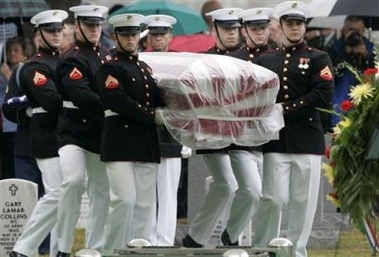
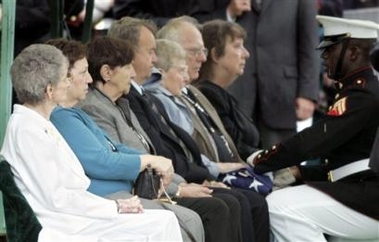
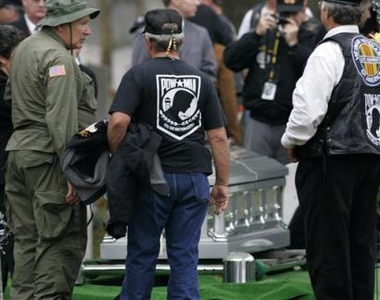
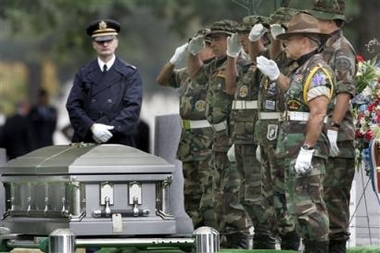
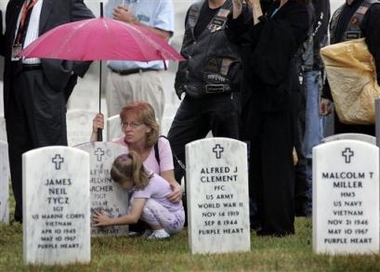
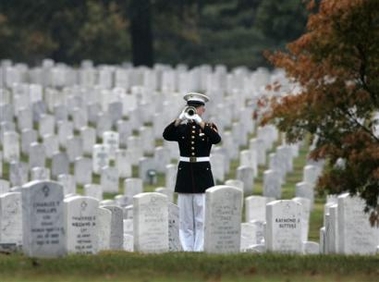
Michael Robert Patterson was born in Arlington and is the son of a former officer of the US Army. So it was no wonder that sooner or later his interests drew him to American history and especially to American military history. Many of his articles can be found on renowned portals like the New York Times, Washingtonpost or Wikipedia.
Reviewed by: Michael Howard

